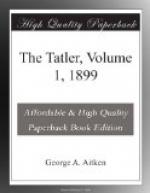[Footnote 420: See No. 39.]
[Footnote 421: Whiston had fixed that day for the destruction of Anti-Christ and the beginning of the Millennium.]
[Footnote 422: Written by Addison in 1705, in celebration of the victory at Blenheim.]
[Footnote 423: The great storm of November 1703 formed the subject of a volume published by Defoe in 1704.]
No. 44. [STEELE.
From Tuesday, July 19, to Thursday, July 21, 1709.
—Nullis amor est medicabilis
herbis.
OVID,
Met. i. 523.
* * * * *
White’s Chocolate-house, July 19.
This day, passing through Covent Garden, I was stopped in the Piazza by Pacolet, to observe what he called the “triumph of love and youth.” I turned to the object he pointed at; and there I saw a gay gilt chariot drawn by fresh prancing horses; the coachman with a new cockade, and the lackeys with insolence and plenty in their countenances. I asked immediately, what young heir or lover owned that glittering equipage? But my companion interrupted: “Do not you see there the mourning AEsculapius?"[424] “The mourning!” said I. “Yes, Isaac,” said Pacolet, “he is in deep mourning, and is the languishing hopeless lover of the divine Hebe, the emblem of youth and beauty. The excellent and learned sage you behold in that furniture, is the strongest instance imaginable, that love is the most powerful of all things. You are not so ignorant as to be a stranger to the character of AEsculapius, as the patron and most successful of all who profess the art of medicine. But as most of his operations are owing to a natural sagacity or impulse, he has very little troubled himself with the doctrine of drugs; but has always given Nature more room to help herself, than any of her learned assistants; and consequently has done greater wonders than is in the power of art to perform;[425] for which reason, he is half deified by the people; and has ever been justly courted by all the world, as if he were a seventh son. It happened, that the charming Hebe was reduced, by a long and violent fever, to the most extreme danger of death; and when all skill failed, they sent for AEsculapius. The renowned artist was touched with the deepest compassion to see the faded charms and faint bloom of Hebe; and had a generous concern in beholding a struggle, not between life, but rather between youth, and death. All his skill and his passion tended to the recovery of Hebe, beautiful even in sickness: but, alas! the unhappy physician knew not, that in all his care he was only sharpening darts for his own destruction. In a word, his fortune was the same with that of the statuary, who fell in love with the image of his own making; and the unfortunate AEsculapius is become the patient of her whom he lately recovered. Long before this disaster, AEsculapius was far gone in the unnecessary and superfluous amusements of old age, in increasing




